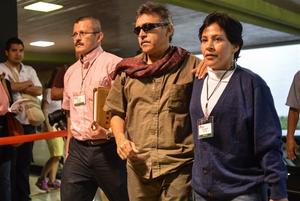Some noticeable, important developments took place last week, which are likely to have far-reaching effects on the peace negotiations between the Revolutionary Armed Forces of Colombia (FARC) and the Juan Manuel Santos government. Chief among these was the FARC's response to the proposals presented by more than 500 civil society organizations articulating the problematic question of land use and distribution in Colombia. More than anything else, the land question is the core problem of the country's 49-year-long armed conflict. The guerrilla organization presented a summary of ten issue areas illustrating what it considered as central, which in turn showed an evolution in its stance.

First, it has amended its position regarding the abolition of the latifundio (large land holdings), first stipulated in its agrarian program of 1964. In its new stance expressed last week, the FARC is calling only for the redistribution of “idle or underused” lands rather than dismantling the whole latifundio system. For example commander Jesus Santrich, one of the five FARC negotiators, said in an interview that from the 40 million hectares that are currently owned by large cattle ranchers, 20 million must be redistributed to poor peasants. In this respect it is important to know that according to estimates of the Federation of Cattle Ranchers (FEDEGAN), between 39 and 41 million hectares are currently dedicated to cattle ranching, 20 million of which are not appropriate for this activity. This is while of the 21,5 million hectares appropriate for food production only 5 million hectares are dedicated to such activity. In my recent study on the Colombia’s rural economy published in the Latin American Research Review (Summer 2012), I argue that among the causes of this contradictory trend in rural development is the speculative-rentier aspect, in which acquiring large swaths of lands can serve multiple purposes including hedging risks, evading taxation, money laundering, and above all, speculation in land prices. This activity can be very lucrative and can explain its significant expansion at the expense of food production over the last two decades.
Now the FARC is shedding light on this problem, bringing it forcefully to the negotiating table by attempting to mobilize popular support from its peasant bases. But the new FARC discourse is targeting specifically cattle ranching lands. This may represent one of the most important shifts regarding the land problem since the Agrarian Program of 1964, which marked its beginning as a guerrilla movement.
The second important evolution in the FARC’s position is towards the lands that the state has granted to multinational, extractive, and mining corporations for exploitation, exploration, and use. These amount to almost 40% of the national territory. The FARC is not calling for the total nationalization or expulsion of the multinational corporations and foreign direct investors but to rationalize, moderate, and re-negotiate contracts in a manner to favor the Colombian people and to protect the environment.
Finally, the FARC is acknowledging the possibility of having multiple modes of production coexisting with all their socioeconomic contradictions and antagonisms. In doing so it is leaving room to negotiate an end to an armed conflict that is at a stalemate, in which, neither the state nor the insurgency has won, and in which, consequently, no party can impose its conditions fully. But the core question remains of whether the Santos government is willing and capable of rationalizing rural development and abandoning its commitment to an economic model that is obsolete and that has proved to be non-viable. This is a model that rests on extraction, biofuels, large agribusiness, and land speculation in which the peasant subsistence economy is unsustainable. The future of Colombia and its durable peace rests on finding a balance between these contradictory modes of productions in which the state would ameliorate, negotiate, and arbitrate between the antagonistic forces. This is something that has never happened in Colombia’s violent past.
Update: see also http://verdadabierta.com/component/content/article/52-farc/4411-de-rioch...
Nazih Richani is the Director of Latin American studies at Kean University. He blogs at nacla.org/blog/cuadernos-colombianos.

